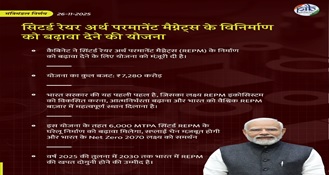08 December, 2025
Approval of REPM Manufacturing Promotion Scheme (English Translation)
Thu 27 Nov, 2025
Context:
- The Union Cabinet has approved a scheme to promote the manufacturing of Sintered Rare Earth Permanent Magnets (REPM) with a financial outlay of ₹7,280 crore.
Key Points:
- The scheme is a strategic step to make India self-reliant in critical minerals under the Aatmanirbhar Bharat Abhiyan, aimed at developing domestic production capacity for high-performance magnets used in electric vehicles (EVs), renewable energy, aerospace, defence, and electronics sectors.
- The objective of the scheme is to establish an integrated REPM production capacity of 6,000 metric tonnes per annum (MTPA), covering the complete value chain from NdPr oxide to NdFeB magnets: Oxide → Metal → Alloy → Finished Magnet.
- Scheme Name: Scheme for Promotion of Manufacturing of Sintered Rare Earth Permanent Magnets (REPM).
- Duration: 7 years (2 years gestation period + 5 years incentive disbursement).
- Total Outlay: ₹7,280 crore (₹6,450 crore sales-based incentives + ₹750 crore capital subsidy).
- Capacity: 6,000 MTPA (5 beneficiaries selected through global bidding, each with 1,200 MTPA).
- Process: Global competitive bidding; creation of integrated facilities.
- Benefits: Employment generation, self-reliance, and support for Net Zero 2070 goals.
- The initiative aligns with the vision of ‘Aatmanirbhar Bharat’ and ‘Viksit Bharat @ 2047’, aiming to make India a global manufacturing hub.
Economic and Social Impact
Economic:
- Localization in EV and renewable energy sectors will promote the growth of auto OEMs and component manufacturers. According to SIAM, this may reduce EV production costs by 2–3%.
- Demand for REPM is expected to double between 2025–2030.
- As per EY India, the initiative will strengthen the critical minerals ecosystem.
Employment:
- Thousands of jobs will be generated through magnet manufacturing and processing facilities, especially in South India.
Environmental:
- Supports clean energy transition; however, responsible mining with ESG standards is essential.
Reducing Dependence on China
- Currently, India depends almost entirely on imports to meet its REPM demand, while China holds nearly 90% monopoly in the global market.
- This presents a major geopolitical risk.
- The scheme will ensure supply-chain resilience for India by reducing Chinese dominance.
Support for Green Energy Goals
- The scheme directly supports India’s Net Zero emissions target for 2070.
- It ensures availability of key components for clean technologies (EVs and wind energy).
- Estimated impact:
– Reduction of about 3 crore litres of oil imports
– Reduction of 16 crore kilograms of CO₂ emissions.
Opportunities
- Global Positioning: India could become an REPM exporter, especially to QUAD nations.
- Industry Response: Welcomed by auto industry bodies like ACMA and SIAM; beneficial for EV and defence sectors.
- Long-Term: Expected contribution to GDP due to rising demand by 2030.
Background and Importance of the Scheme
- Rare Earth Elements (REE) such as Neodymium (Nd), Praseodymium (Pr), and Dysprosium (Dy) are used to make REPM — the strongest permanent magnets in the world, with no substitutes.
- These magnets are essential for EV motors, wind turbines, fighter jets (e.g., F-35), smartphones, MRI machines, and defence equipment.
Current Situation
- India imported more than 53,000 metric tonnes of REPM in FY 2024-25, mainly from China (which produces 90% of global output).
- Since April 2025, China’s strict export controls (in response to US tariffs) have affected Indian automobile and EV industries, causing production delays and price hikes.
- India has 6.9 million tonnes of REE reserves (5th largest in the world), mainly along the coasts of Kerala, Odisha, and Andhra Pradesh.
- However, due to limited processing capacity, India remains import-dependent.


















